10 most interesting employee motivation statistics
- 85% of employees worldwide are not engaged which means only 15% of employees feel actively engaged and motivated at work.
- U.S. employee engagement dropped from 36% in 2020 to 31% in 2024, showing a steady decline in motivation and connection to work.
- 61.2% of construction industry employees are highly motivated which is the highest motivation rate across all industries.
- 60% of UK employees feel motivated at work which is 11% lower than the global average of 71%.
- 17% of U.S. employees are actively disengaged as of 2024, an increase from 14% in 2020, signaling rising dissatisfaction.
- Only 52% of employers in the chemical industry consider motivation and self-awareness essential which are the lowest ranking across industries.
- Gen Z (42%) and Millennials (40%) prioritize purpose-driven work, whereas Gen X (34%) and Baby Boomers (32%) seek financial stability and career security.
- Companies with highly engaged employees outperform others by 21%, highlighting the strong link between motivation and profitability.
- 69% of employees say they’d work harder if their efforts were better recognized, proving simple appreciation is a powerful motivator.
- 56% increase in productivity is seen when managers align employee goals with organizational priorities – showing clear communication and expectations boosts motivation.
What is employee motivation, and why does it matter?
Employee motivation is the internal drive and commitment employees have toward achieving workplace goals. High motivation enhances productivity, reduces turnover, and boosts organizational performance, making it critical for business success.
General employee motivation statistics in the U.S.
Current employee motivation levels data in the US (2024/2025)
As of 2024, 85% of employees are either not engaged or are actively disengaged. That means only 15% of employees are actively motivated at work.
Source: Gallup
Current employee motivation levels data in the UK and global (2024/2025)
In the UK, only 60% of UK workers feel motivated, which is 11% less than the global average. The global average is 71%. It is easy to conclude that other countries and markets are more motivated and more effective, which will result in huge effectiveness losses for the US.
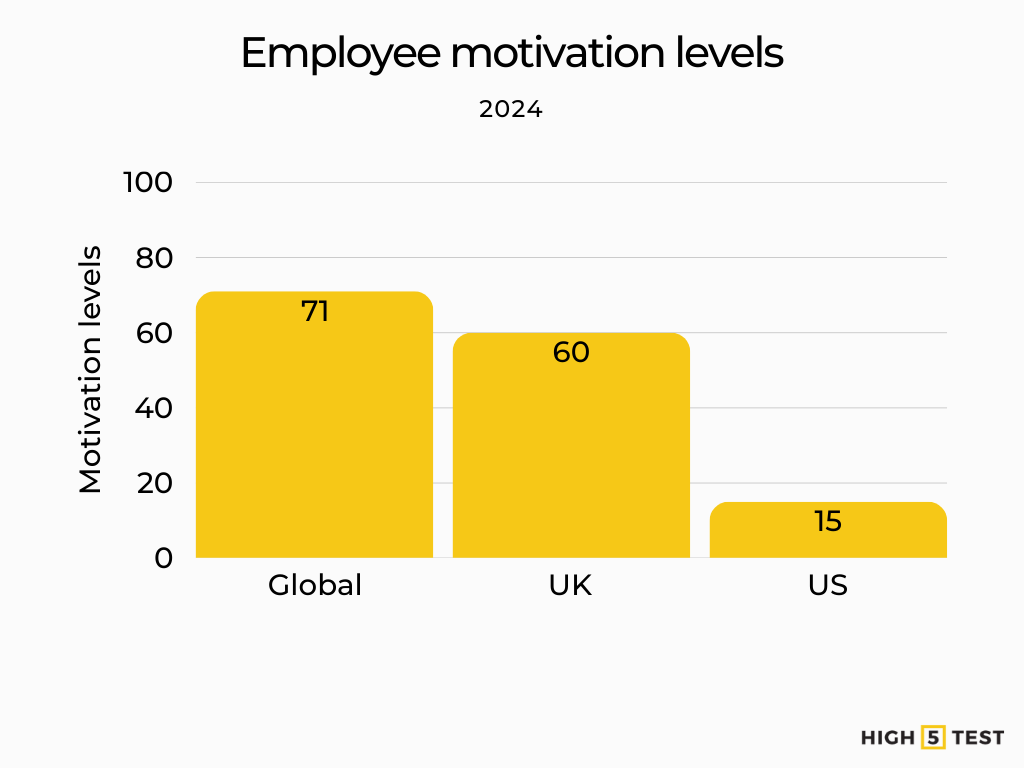
Source: Gallup, EFX and Korn Ferry
Historical trends and how motivation levels have changed over time
| Year | Percentage of Engaged Employees in the US | Percentage of Actively Disengaged Employees in the US |
|---|---|---|
| 2020 | 36% | 14% |
| 2021 | 34% | 16% |
| 2022 | 32% | 17% |
| 2023 | 33% | 16% |
| 2024 | 31% | 17% |
These figures indicate a general decline in employee engagement from 2020 to 2024, with a corresponding increase in actively disengaged employees. The year 2024, in particular, saw engagement levels matching those of 2014, highlighting a decade-long trend of diminishing motivation among U.S. workers.
Source: McKinsey
Employee motivation across different industries
Industries with the highest employee motivation levels
Industries such as construction (61%), professional and business services (55%), and financial services (54%) have the highest motivation levels, driven by job stability, market growth, innovation, and career advancement opportunities.
| Industry | Motivation Levels |
|---|---|
| Construction | 61.20% |
| Professional and business services | 55.20% |
| Utilities | 54.00% |
| Financial activities | 53.50% |
| Transportation and warehousing | 48.90% |
Source: Glassdoor
Industries facing motivation challenges (and reasons behind them)
Here are the five sectors in the United States with the lowest percentage of employers who consider “motivation and self-awareness” a core skill for their workforce in 2025:
| Sector | Motivation and Self-Awareness Recognition |
|---|---|
| Chemical and Advanced Materials | 52% |
| Real Estate | 54% |
| Mining and Metals | 55% |
| Oil and Gas | 56% |
| Production of Consumer Goods | 57% |
Source: The World Economic Forum
Employee motivation by demographics
Motivation across generations: Gen Z, Millennials, Gen X and Boomers
Gen Z (42%) and Millennials (40%) prioritize purpose-driven work, whereas Gen X (34%) and Baby Boomers (32%) often seek financial stability and career security.
| Motivation across generations | Percentage | Main motivation |
|---|---|---|
| Gen Z | 42% | Purpose-driven work |
| Millennials | 40% | Purpose-driven work |
| Gen X | 34% | Financial stability & career security |
| Baby Boomers | 32% | Financial stability & career security |
Source: Deloitte
Gender differences in employee motivation
Female employees (39%) are typically motivated by work flexibility and career advancement, while male employees (35%) are more influenced by salary increases and leadership positions.
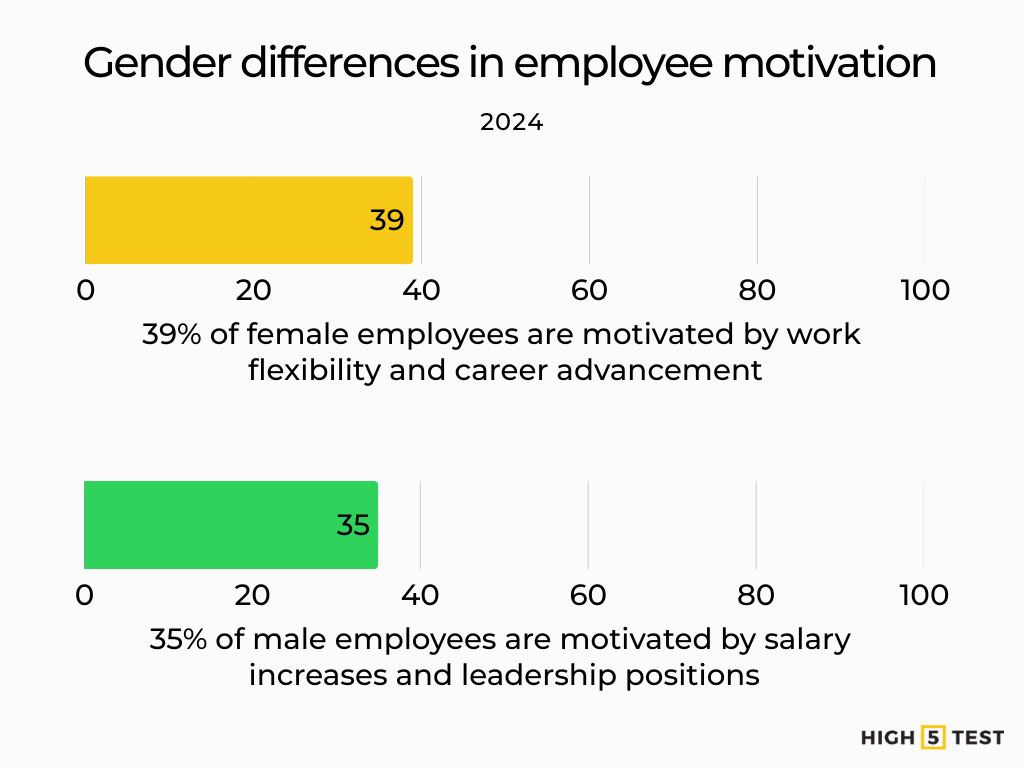
Source: YOH
How education level impacts employee motivation
Higher educational attainment is associated with higher earnings and lower unemployment rates, factors that may contribute to greater job satisfaction and motivation.
The reports the following median weekly earnings for full-time wage and salary workers aged 25 and over:
- Less than a high school diploma: $682
- High school diploma: $853
- Some college, no degree: $935
- Associate’s degree: $1,005
- Bachelor’s degree: $1,432
- Master’s degree: $1,661
- Professional degree: $2,080
- Doctoral degree: $2,083
Individuals with a bachelor’s degree earn approximately 67% more than those with only a high school diploma. Those with a master’s degree earn about 95% more than high school graduates.
Source: BLS
The BLS also provides the following unemployment rates for the same demographic:
- Less than a high school diploma: 5.5%
- High school diploma: 4.0%
- Some college, no degree: 3.5%
- Associate’s degree: 2.7%
- Bachelor’s degree: 2.2%
- Master’s degree: 1.9%
- Professional degree: 1.4%
- Doctoral degree: 1.0%
These statistics indicate that individuals with a bachelor’s degree have a 45% lower unemployment rate compared to those with only a high school diploma.
Source: BLS
Factors influencing employee motivation
Top 5 factors employees say motivate them most
Employees identify that recognition and appreciation (81%), growth and development (72%), meaningful work (90%), work-life balance (93%), and compensation and benefits (55%) are the most influential factors that motivate US employees.
| Motivating factors | Percentage |
|---|---|
| Work-life balance | 93% |
| Meaningful work | 90% |
| Recognition and appreciation | 81% |
| Growth and development | 72% |
| Compensation and benefits | 55% |
Source: WorkTango, Randstad, Pollack, ALA-APA, PeopleThriver
How salary and financial incentives impact employee motivation
Financial incentives significantly boost motivation up to a market-average salary level, beyond which motivation tends to plateau. This study demonstrates that properly constructed incentive programs can enhance performance by up to 44%. It emphasizes the importance of well-designed incentives in boosting employee motivation and performance.
57% of U.S. employees stated that working for commissions or bonuses motivates them to perform better, and over half (52%) said it motivates them to achieve their goals.
Source: IRF, CaptivateIQ
The crucial role of recognition and praise
Regular praise and recognition can increase employee motivation, directly impacting productivity and retention. 90% of employees say that receiving recognition for their work motivates them to put in more effort. Just under 40% of employees feel underappreciated.
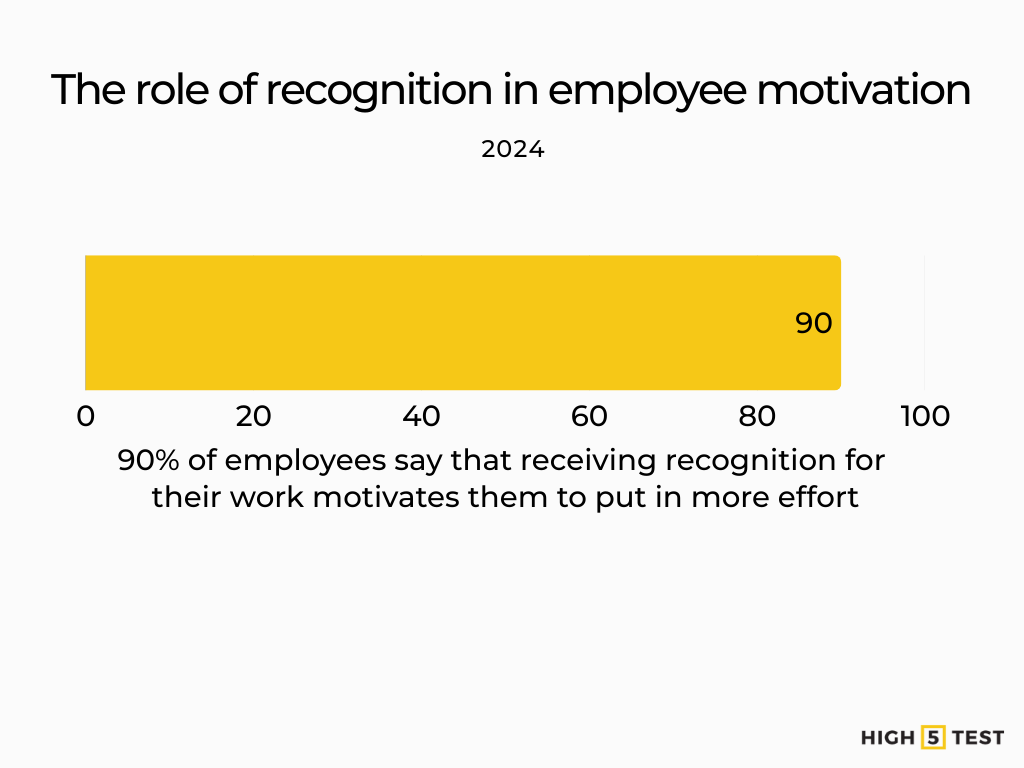
Source: Achievers Workforce Institute
Learning and career growth opportunities and their influence on motivation
84% of employees agree that learning adds purpose to their work which helps them with their motivation and career development. Career development grows when employees feel in control of their careers.
Source: LinkedIn Learning
Employee motivation and workplace environment
How workplace culture shapes employee motivation
The results indicated that a positive work environment had the power to improve employee performance. Companies with strong cultures tend to outperform their competitors, with a 20% increase in employee satisfaction leading to a remarkable 10-30% rise in productivity.
A study shows that there is a negative correlation between employee stress and productivity and it’s made definitive that high-performance teams and organizations that place employees under huge amounts of stress lead to a decrease in efficiency and productivity.
Source: PsicoSmart and PMC
Remote vs. in-office: Which environment fosters more motivation?
Employees working in hybrid setups exhibit the highest motivation (47%), compared to those fully remote (39%) or fully office-based (34%).
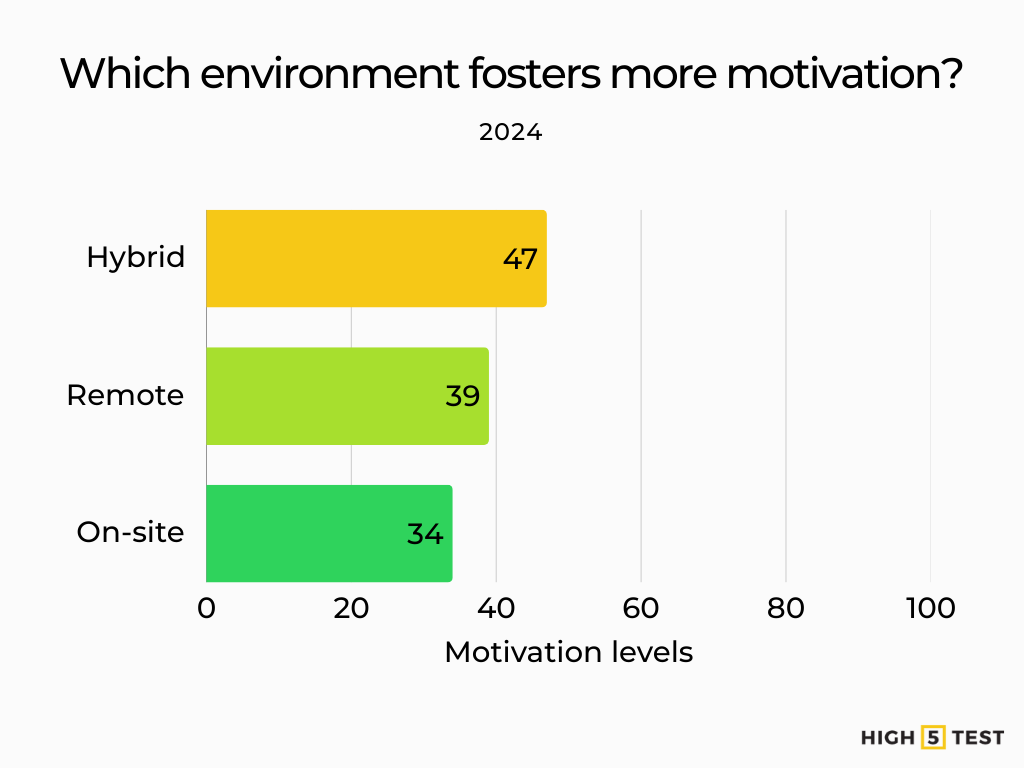
Source: Owl Labs
The impact of flexible and hybrid work on motivation levels
In the U.S., 76% of full-time hybrid workers identify enhanced work-life balance as a key benefit of their hybrid work arrangement. This feeling is even stronger among fully remote workers, with 85% highlighting improved work-life balance as one of the top advantages of remote work.
Source: Gallup
Consequences and effects of employee motivation
Connection between employee motivation and productivity
Motivated employees are approximately 20% more productive, directly improving organizational performance and efficiency.
Source: Gallup
Employee motivation and company profitability
Companies with highly motivated teams see 23% higher profitability, driven by increased productivity, better service quality, and reduced absenteeism.
Source: Gallup
The high cost of low employee motivation: Turnover and performance losses
A lack of employee engagement costs the U.S. economy approximately $1.9 trillion annually in lost productivity.
Source: Gallup
Employee motivation and retention
How motivated employees affect retention rates
Highly motivated and engaged employees show 68% less turnover likelihood, significantly reducing costs related to employee replacement.
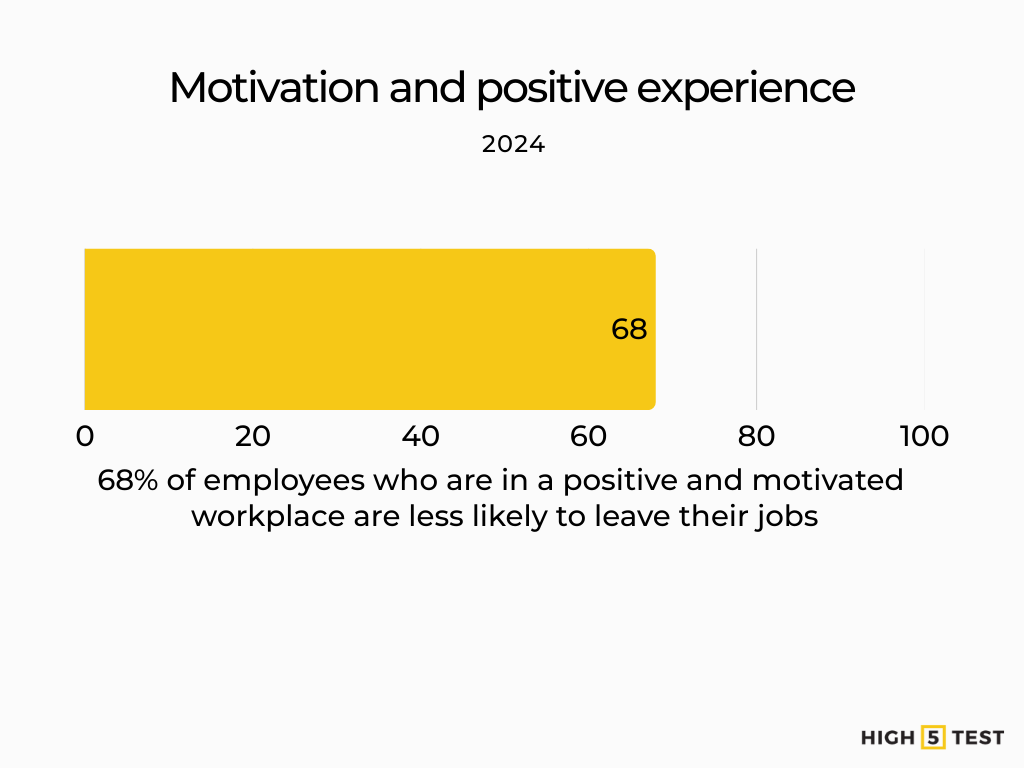
Source: SHRM
Employee motivation and leadership
Leadership styles and their impact on employee motivation
Four in five employees don’t trust their leadership in organizations. The indicator showed that only 20% of employees trust their leadership.
Approximately 70% of the difference in employee engagement scores is solely affected by the manager. That’s another proof of how leaders and important and influential.
Teams led by transformational leaders report a 50% increase in employee engagement compared to those led by more traditional leadership styles. Additionally, workplaces characterized by transformational leadership experience a 22% increase in productivity.
Almost every employee (92%) confirmed that trust in leadership is an important factor for motivation levels.
Source: Gallup, Gallup, UCLA and PWC
Employee motivation and employee well-being
The link between employee motivation, mental health, and wellness
It is reported that 77% of employees experience work-related stress. Additionally, 57% of them are feeling the negative effects of it these two in the first places: emotional exhaustion (31%) and feeling unmotivated (26%).
This concerning research by SHRM’s Employee Mental Health, states that more than two in five adults (44%) of surveyed U.S. employees feel burned out.
How companies prioritizing wellness improve motivation statistics
There is a significant misalignment between U.S. employers’ and employees’ priorities regarding well-being support. Employers are focusing on emotional (66%) and physical (52%) well-being initiatives. However, employees identify financial well-being as their primary concern (59%), despite only 22% of employers prioritizing it.
| Employees’ priorities | What US employers offer | What US employees want | The gap between employer & employee |
|---|---|---|---|
| Emotional well-being | 66% | 41% | +25 |
| Physical well-being | 52% | 40% | +12 |
| Employee experience | 50% | 40% | +10 |
| Social well-being | 17% | 20% | -3 |
| Financial well-being | 22% | 59% | -37 |
Source: WTW
Employee motivation vs. career changes
How motivation levels influence career decisions
60% of respondents considered quitting their jobs due to feeling disrespected or undervalued at work.
Other reasons influencing career change evaluation are remote work options (67%), improved work-life balance (52%), greater job fulfillment (48%), and expanded skill sets (40%).
69% of respondents have switched career fields or are templated making a change in the past year which is surprisingly high. That means 7 in 10 are considering making a career change.
Source: FlexJobs
Statistical link between employee motivation and career transitions
Employees who consistently report high motivation are 70% less likely to change careers, reflecting motivation’s critical influence on career stability.
Another study confirmed the crucial importance of motivation, stating that highly motivated and engaged employees have 68% less chance to quit their jobs, significantly reducing costs related to employee replacement.
Strategies to improve employee motivation
Employee recognition
A study found that when all employees have an equal opportunity to earn recognition for their efforts, they are 2.2 times more likely to go above and beyond their regular duties.
Respondents shared their thoughts in their own words, but a clear trend emerged, 37% said that greater personal recognition would inspire them to produce better work consistently.
Increasing weekly recognition can lead to a 24% improvement in work quality, a 27% reduction in absenteeism, and a 10% decrease in shrinkage.
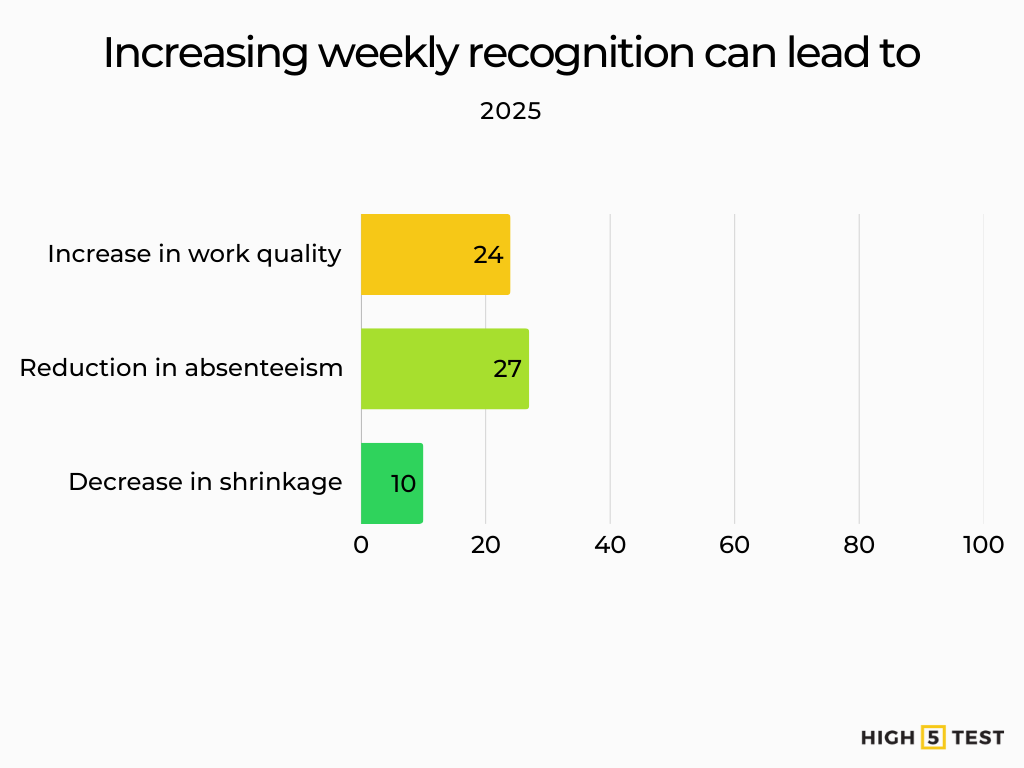
Source: GreatPlaceToWork and Achievers
Peer-to-peer recognition
Organizations with peer-to-peer recognition programs are 35.7% more likely to have a positive impact on financial results compared to those with supervisor-only recognition.
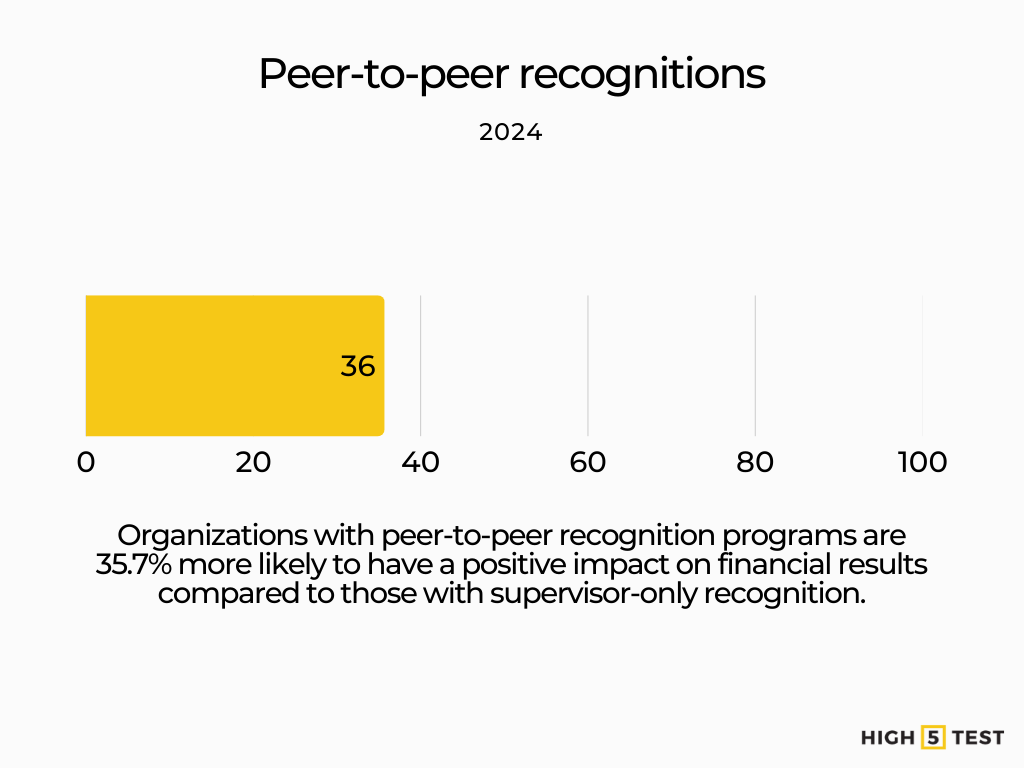
Source: SHRM
Strength-based approaches: Leveraging employee strengths to boost motivation
Motivation can increase by 36% when managers tailor roles to leverage employees’ strengths. This change boosts productivity and improves overall job satisfaction and motivation.
Source: Gallup and Distant Learning College
Role of employee assessments in driving motivation (strength & career aptitude tests)
Employee assessments such as strengths tests and aptitude tests effectively boost motivation and engagement up to 6x, by aligning employees with roles best suited to their natural talents, strengths and interests.
SOURCE: Gallup
Global and regional insights on employee motivation
Countries with highest employee motivation rates
A survey of 10,000 employees worldwide reveals that only 60% of UK professionals feel motivated to go above and beyond in their roles, lower than the global average of 71%. In fact, the UK recorded the lowest motivation levels among all regions studied.
By contrast, about 75% of U.S. employees reported high motivation, while India leads in 2024 with 84% of its workforce driven to exceed expectations.
Source: Korn Ferry
Comparative analysis: U.S. vs. Europe vs. Asia-Pacific vs. Other
The data presented in the report is for the year 2024, and it also includes some data from 2023 for comparison and trend analysis.
| Metric | Europe | US | Asia-Pacific | Other (Africa) | Other (South America) |
|---|---|---|---|---|---|
| Engagement Rate (approx.) | 10-13% | ~31% | Varies | ~20-29% | ~32% |
| Trend | Declining | Declining | Mixed | Stable/Improving | Stable |
| Key Drivers | Well-being, Change Mgmt, Leadership, Recognition | Clarity of Expectations, Feeling Cared About, Development | Organizational Support, Purpose, Job Security (varies) | Working Conditions, Pay, Growth | Pay, Development, Leadership, Culture |
| Key Challenges | Low Well-being, Poor Change Mgmt | Lack of Clarity, Feeling Uncared For, Limited Growth | Stress, Presenteeism, Cultural Variation | Stress, Low Pay, Limited Opportunities | Pay Dissatisfaction |
In 2024, global employee engagement remained low at 23%, with stagnation observed across various sectors, including IT.
Future of employee motivation
Emerging trends shaping motivation beyond 2025
By 2030, personalized employee experiences, mental health initiatives, and flexible, adaptive workplaces are expected to dominate motivational strategies, potentially improving employee motivation by up to 30%.
Source: Deloitte
Impact of AI, automation, and technology on employee motivation
Anticipations are that automation and AI will increase overall employee motivation by approximately 25% by eliminating routine tasks, and allowing employees to engage more deeply in creative and strategic activities.
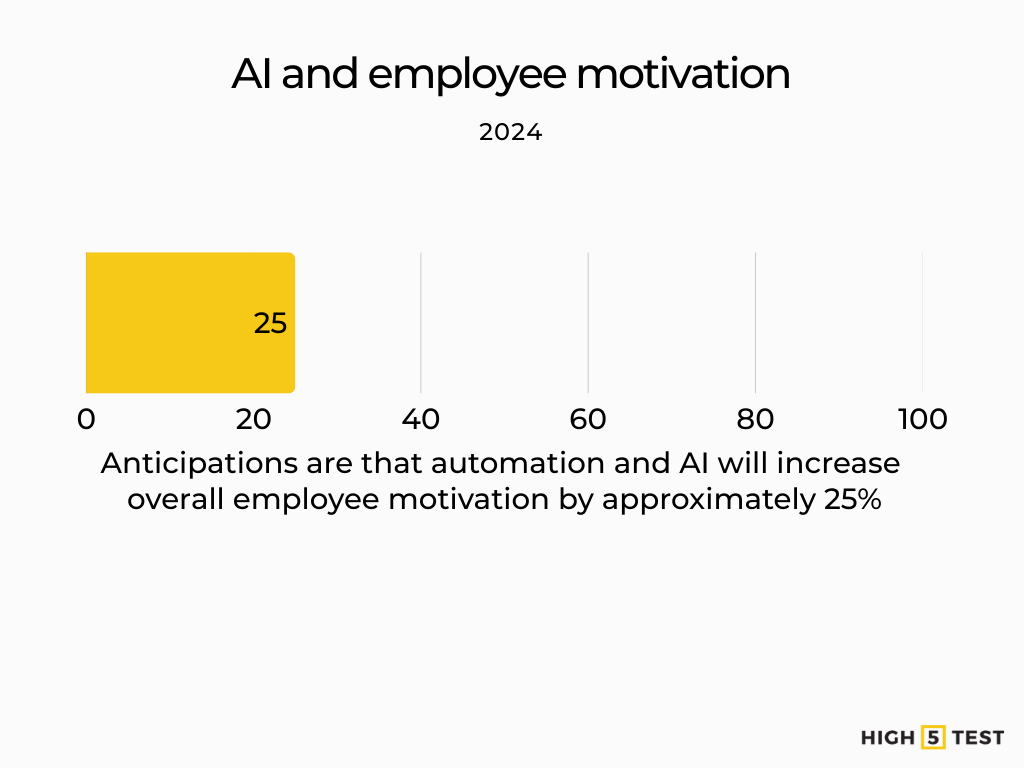
Source: World Economic Forum
Conclusion: Importance of employee motivation
High employee motivation significantly enhances productivity, profitability, and employee retention. Organizations that actively invest in motivation through structured feedback, recognition, wellness initiatives, and adaptive leadership strategies consistently outperform their peers.
Employee motivation FAQ
What motivates employees the most?
Employees are motivated by a combination of intrinsic and extrinsic factors. Intrinsic motivators include a sense of purpose, personal growth, and the satisfaction derived from meaningful work. Extrinsic motivators involve tangible rewards such as competitive compensation, recognition, and opportunities for advancement. Understanding that each employee may prioritize these factors differently is crucial for effective motivation.
How do companies motivate employees?
Companies employ various strategies to motivate employees, including: Providing competitive compensation and benefits: Offering salaries and benefits that meet or exceed industry standards. Recognizing achievements: Implementing programs to acknowledge and reward employee accomplishments. Offering professional development opportunities: Providing training and career growth prospects. Fostering a positive work environment: Cultivating a culture of respect, collaboration, and work-life balance. Ensuring transparent communication: Keeping employees informed about company goals, changes, and their role in achieving them.
Why is it important to motivate employees?
Motivated employees are more engaged, productive, and committed to their work. They are more likely to contribute innovative ideas, collaborate effectively with colleagues, and remain loyal to the organization. This leads to improved performance, higher job satisfaction, and reduced turnover rates, ultimately benefiting the organization’s success and growth.
How does employee motivation affect organizational behavior?
Employee motivation plays a pivotal role in shaping organizational behavior, influencing various aspects that contribute to a company’s success. Motivated employees exhibit higher productivity and consistently produce quality work, directly enhancing organizational performance. They are more engaged in their tasks and committed to the organization’s objectives, fostering a culture of dedication. This engagement leads to a collaborative and supportive environment, enhancing teamwork and mutual respect among employees. Furthermore, high motivation levels are associated with lower absenteeism and improved talent retention, ensuring organizational stability. Additionally, motivated employees are better problem-solvers and exhibit higher levels of innovation and creativity, driving organizational growth and competitiveness.
Who is responsible for employee motivation?
While employees play a role in their own motivation, organizations and leaders hold primary responsibility. Management should create an environment that supports and encourages motivation through recognition, opportunities for growth, and a positive work culture. Collaborative efforts between employees and employers are essential for sustaining high motivation levels.

